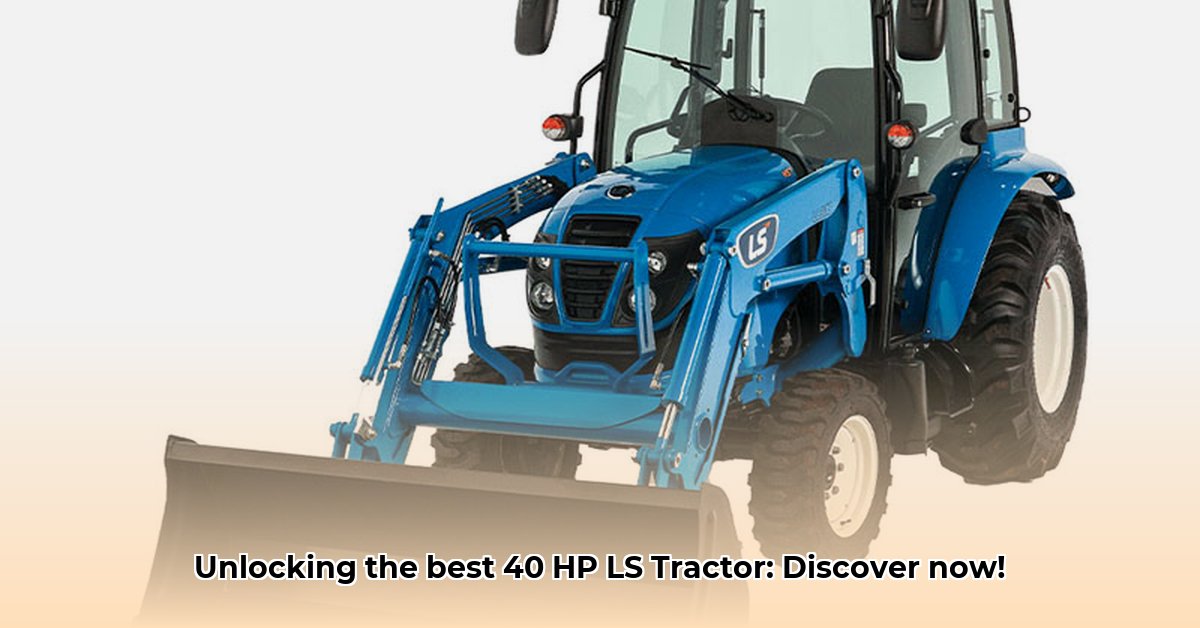
40 HP LS Tractors: A Comprehensive Guide for Sustainable Agriculture
Choosing the right tractor is pivotal for any farmer, particularly those prioritizing sustainable practices. This guide focuses on LS Tractors within the 40-99 horsepower range, analyzing their suitability for environmentally conscious farming operations. We will compare LS models, assess their performance against competitors like John Deere, Kubota, and Mahindra, and investigate factors such as price, fuel efficiency, reliability, and environmental impact. For comparison, you might also research other brands like Massey Ferguson tractors.
LS Tractor's 40-99 HP Lineup: Model Overview
LS Tractor provides several models in the 40-99 HP range, each tailored to different farming needs and scales of operation. Understanding the key features and specifications is vital for selecting the appropriate model. The following table summarizes key characteristics; however, always verify specifications with LS Tractor or your local dealer.
| Model | Engine HP | Transmission Type | PTO HP | Hydraulic Remotes | Weight (lbs) (Approximate) | Fuel Capacity (gal) (Approximate) | Typical Applications |
|---|---|---|---|---|---|---|---|
| MT225E | 24.7 | HST | 22 | 2 | 2434 | 7.4 | Small farms, orchards |
| MT240HE | 24.7 | HST (Hydrostatic Transmission) | 22 | 2 | 2646 | 7.4 | Small farms, orchards |
| MT347HC | 35.3 | 16 Speed Sync (Gear) | 32 | 2 | 3417 | 12.0 | General farm work |
| MT357PCT | 57 | Gear | 47 | 2 | 4500 (Estimated) | 15.0 (Estimated) | Haying, Livestock |
| MT468CPS | 68 | Gear | 55 | 3 | 5500 (Estimated) | 18.0 (Estimated) | Larger farms, heavy use |
Note: Weight and fuel capacity are approximate and can vary based on configuration. Consult official specifications.
LS vs. Competitors: John Deere, Kubota, Mahindra
Comparing LS tractors to established brands like John Deere, Kubota, and Mahindra requires a multi-faceted approach. While LS often offers competitive pricing, readily available parts and extensive dealer networks become crucial considerations. Kubota, for example, often boasts a superior service network, potentially offsetting a higher initial purchase price. John Deere and Mahindra offer various models with overlapping capabilities, necessitating a direct comparison based on specific needs.
Do you prioritize a large dealer network for quick repairs and parts acquisition, or will a more independent approach suit your operation better? This question is central to selecting the right tractor manufacturer for your needs.
Performance, Reliability, and Maintenance
Real-world performance varies depending on application and maintenance. User reviews highlight the efficiency and reliability of LS Tractors in many instances. However, challenges obtaining parts in certain regions have been reported. Comparing maintenance schedules and costs between different brands is essential for calculating the total cost of ownership.
Sustainability and Environmental Considerations
All models mentioned generally meet current emission standards, contributing to sustainable agriculture. However, comprehensive sustainability evaluation requires examining fuel consumption data, hydraulic system efficiency, and the entire lifecycle assessment of the tractor's production. While initial data is promising, deeper research is required to make definitive sustainability claims.
Pricing and Value Proposition: A Holistic View
The initial purchase price is only one aspect of the overall cost. Factors such as fuel efficiency, maintenance costs, and parts availability significantly influence the long-term value. LS tractors may come with a competitive price tag, but the associated costs of ownership must be carefully assessed against models from established brands with wider support networks.
Conclusion: Selecting the Right Tractor for Your Needs
LS Tractors offer a compelling entry point into the 40-99 HP market, especially for budget-conscious farmers. However, potential buyers should carefully consider the trade-offs between price and the availability of parts and servicing. A proactive approach involving dealer visits, test drives, and comparisons across various brands will invariably result in a more informed and suitable tractor selection. Remember to factor in the long-term costs alongside the initial purchase price to secure the best value for your investment.